“One belongs to New York instantly, one belongs to it as much in five minutes as in five years.”
Tom Wolfe
The 1939-40 World’s Fair celebrated the 150th anniversary of the inauguration of George Washington, which took place in New York City, the original first capital of the nation. Declared “everyman’s fair” it was designed to “show the most promising developments of production, service and social factors of the present day.” From this arose the slogan “Building the World of Tomorrow.”
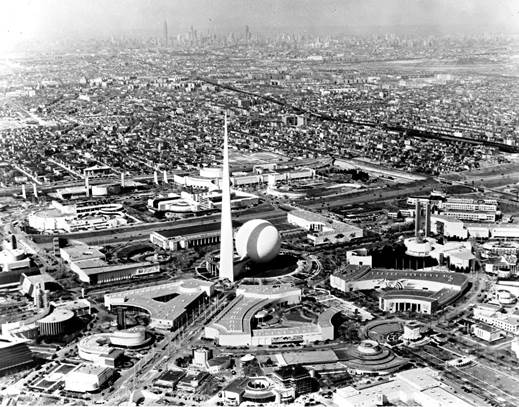
Covering 1,216 acres in Flushing Meadows, the fair stretched for 3.5 miles. On opening day, 206,000 visitors attended, many witnessing President Franklin Roosevelt’s opening speech. Thousands more watched the speech on 200 televisions placed in various locations throughout the fair. Because many thought television was somehow a trick – manufacturers decided to create one tv with a transparent case, so people could see the internal components. General Electric, Westinghouse and the RCA pavilions all displayed televisions.
In addition Westinghouse created a Time Capsule that was not be opened for 5,000 years (the year 6939). Can you guess what it contained? (Answer at the end). What do you think a time capsule of today should contain?
| The Trylon, a three sided pylon, rose nearly 700 feet in the air, and the companion Perisphere measured 185 feet in diameter. Made of reinforced steel and concrete, the two structures weighed nearly 10,000 tons, and could be seen from almost anywhere at the fair. Pictured here is a workman standing on the Perisphere. | 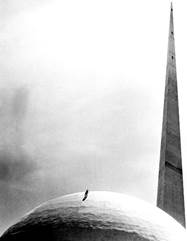 |
The Trylon and Perisphere were featured on every type of souvenir, including the ubiquitous handkerchief. Detailed handkerchief maps could save a fairgoer from becoming lost. More durable than a paper map, they made a great fashion accessory as well.
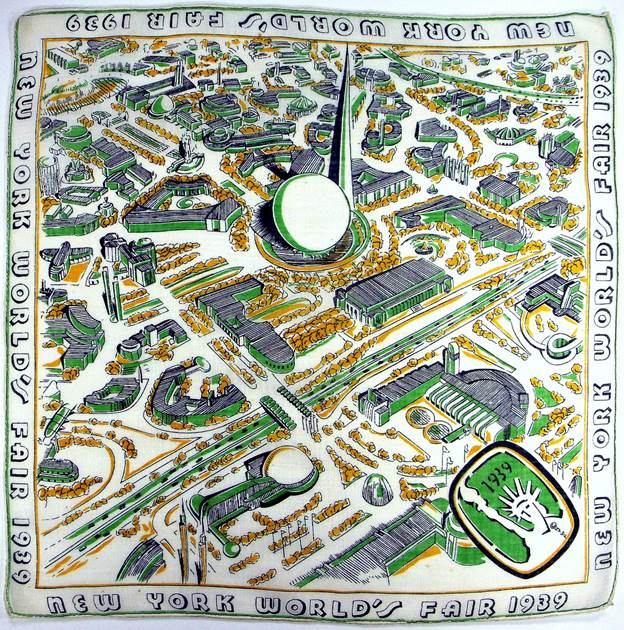
The attention to detail made navigation easy.
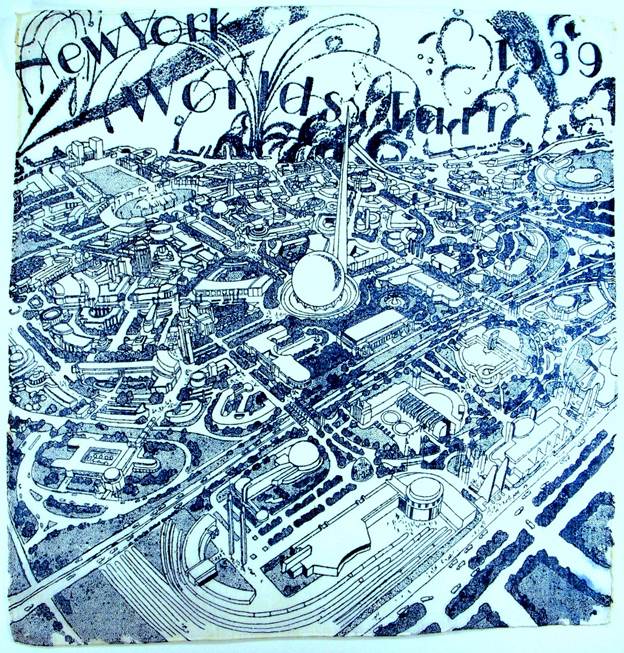
The giant landmarks could be found in every permutation from sleek and modern, to humble and homemade.
 |
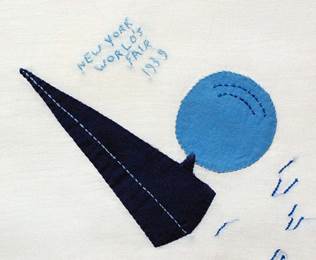 |
A silk souvenir handkerchief envelope for storing hankies.
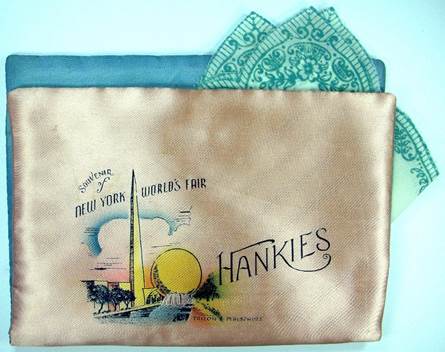
|
A circular skyway which led into the Perisphere not only created a sense of anticipation for fairgoers, it helped to alleviate crowds at ground level. Inside the Perisphere was a diorama called “Democracity”, a model of the utopian city of the future, planned to house 1,000,000+ people.
|
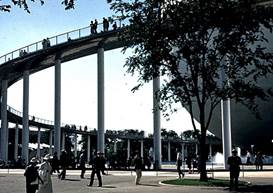 |
|
Particularly spectacular when illuminated at night, you can see the silhouette of Washington against the backdrop of the glowing Perisphere. Elegant statues of the Four Freedoms (Speech, Press, Religion, Assembly) by Leo Friedlander grace Constitution Mall and the reflecting pool. Note the tiny people seated at the base of the statues and strolling on the mall.
|
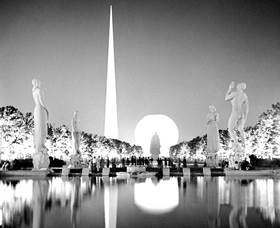 |
 |
 |
Here’s a bird’s eye view of the monumental George Washington statue set against the backdrop of the reflecting pool and double colonnade of trees. The same image is featured below in the center of this chartreuse, geranium and navy beauty.
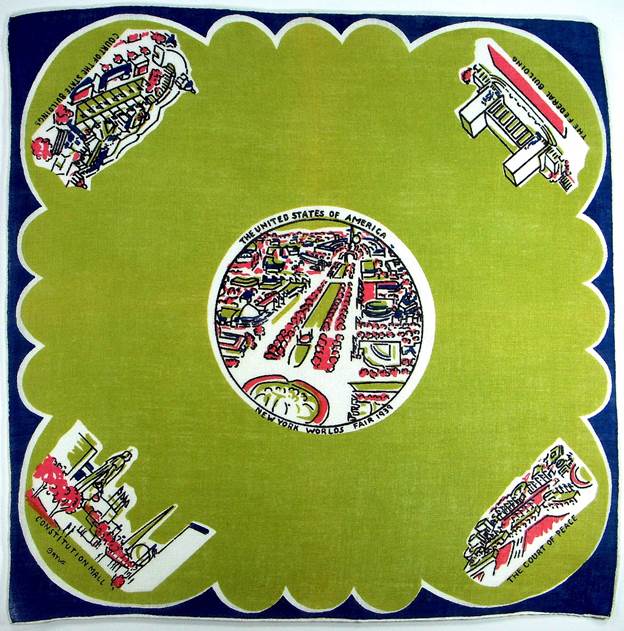
Handkerchief styles ran the gamut, from flowery and feminine

To sleek and sophisticated
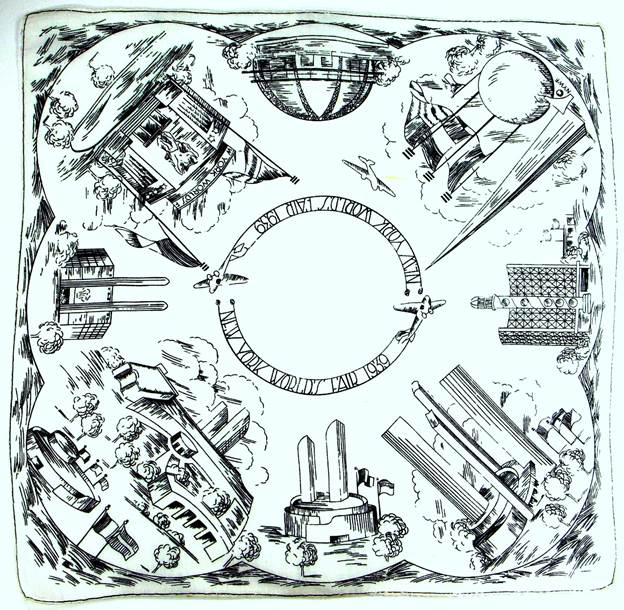
Most handkerchiefs featured multiple pavilions. Note the hankie on the right includes the Florida Pavillion in the northeast corner. Each of the 48 states had their own pavilion.
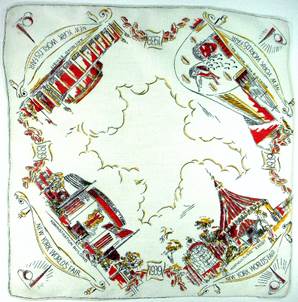 |
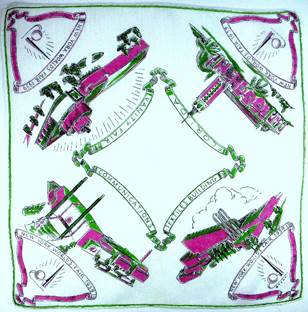 |
Note the Administration Building and Music Hall are featured in the hankie on the upper left. Below, each pavilion is also showcased solo on a handkerchief. Many hankies focused on a single pavilion or exhibit, a treat for collectors who favored a singular subject.
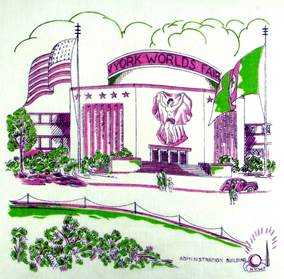 |
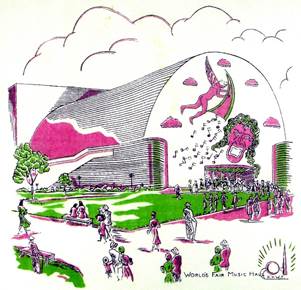 |
Handkerchiefs, like postcards, were popular collectibles and often kept in albums. This Czechoslovakian handkerchief was found sewn to a page in a souvenir handkerchief album. You may be able to see some lines of demarcation where it was originally folded back to fit on the page. I consider this a very special hankie as the Polish Pavilion and Czechoslovakian Pavilion were only open for the 1939 season. By 1940, with war raging in Europe, the two countries closed their pavilions, selling the artifacts to raise money for the war effort. In fact the Fair’s theme of “Building the World of Tomorrow” was changed to “For Peace and Freedom” in 1940. (Hitler invaded Czechoslovakia one month before the fair opened in 1939.)
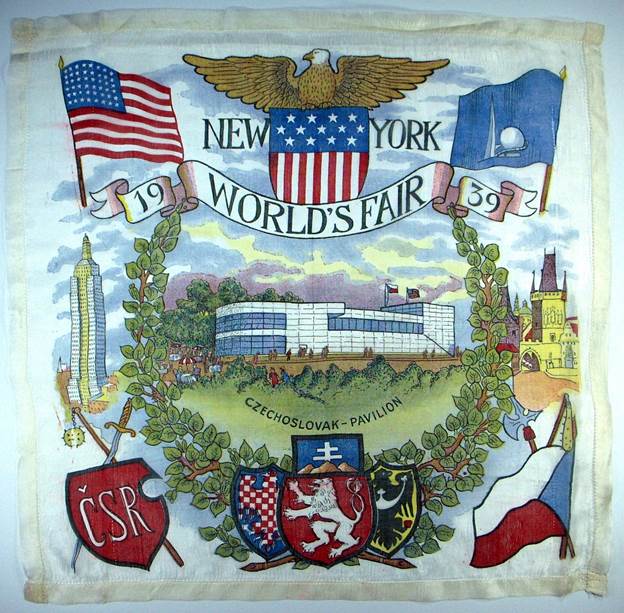
This tiny, colorful silk pocket square limits itself to a single image
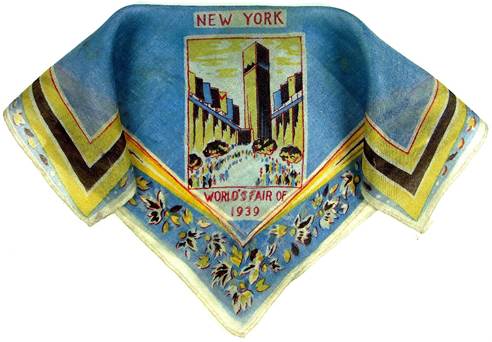
While this rayon number features every pavilion imaginable in a riot of activity and color.
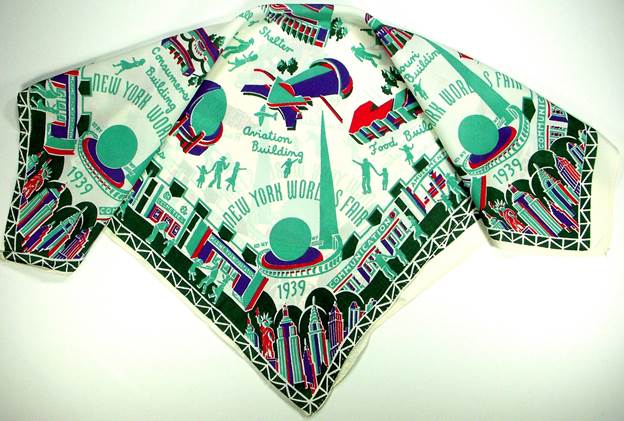
Speaking of rayon and other man-made fabrics, here’s a souvenir crafted from “genuine machine-made” lace, as evidenced by the unfinished cut edges, flat appearance, and uniformity of stitches. Today we prize handmade lace, recognizing not only the skill, but investment of time taken to complete a piece. But the fair was meant to showcase “modern” technology, and prized this creation for the time saver that it was.
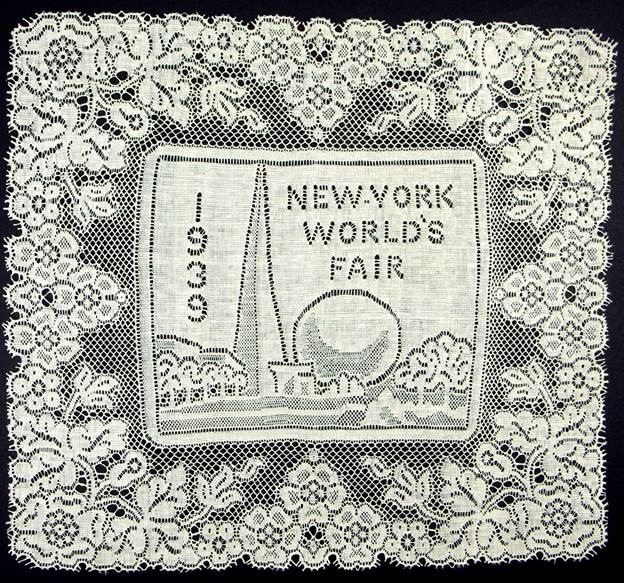
| In the spirit of modernism, Norman Belle Geddes designed the Futurama Pavilion for General Motors, featuring the “City of the Future” (1960). The fair’s most popular exhibit, it attracted 28,000 visitors per day, and five million people during the life of the fair. Viewers rotated around a huge scale model that featured more than 500,000 buildings, 1,000,000 trees and 50,000 automobiles. The exhibit predicted vast multi-lane highways, some 14-16 lanes wide! As David Rejeski quipped “This was Google Earth without the internet.” (You can see two children standing in the city in the video at the end.) | 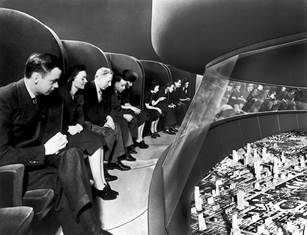 |
The fair was divided into zones – Transportation, Communication and Business Systems, Food, Government, etc. There was even an Aquacade show of water, music and synchronized swimming in an amphitheater which seated 10,000 people. Admission was .75 ($12.76 in today’s dollars. In 1939, based on a 40 hr. work week, an average weekly salary was $26.30. An average hourly wage was 66 cents.)
After visiting the fair, out of towners would then, of course, reserve time to take in the sites of New York City. This series of handkerchiefs contain the date 1939 and one wonders if they, too, were sold at the Fair. Note the variation in background patterns, not only to suit individual tastes, but to provide variety for the collector. From the Waldorf Astoria to the Chrysler Building, the George Washington Bridge, and Public Library…
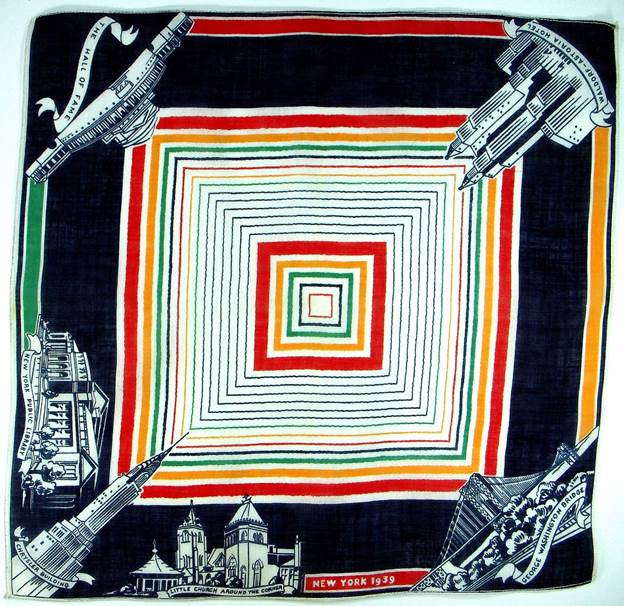
To the Empire State building, the Planetarium, the Aquarium, the Church of St. John the Divine….
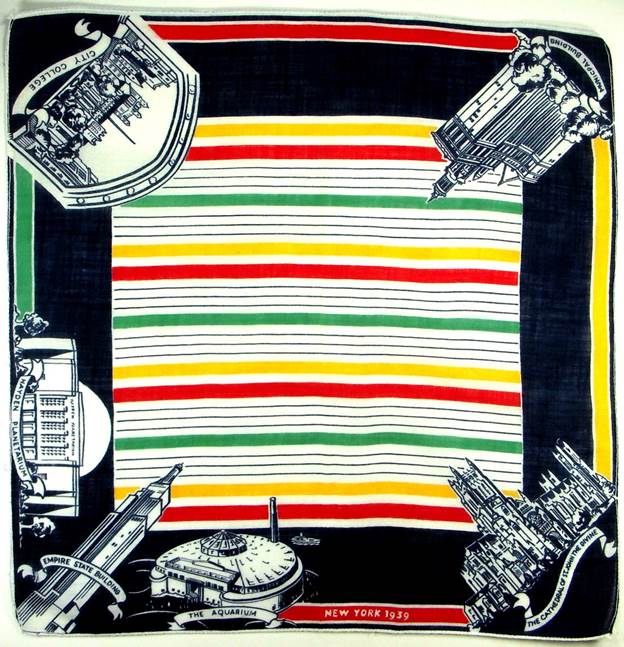
To the Statue of Liberty, the Washington Arch, Radio City to Grant’s Tomb…
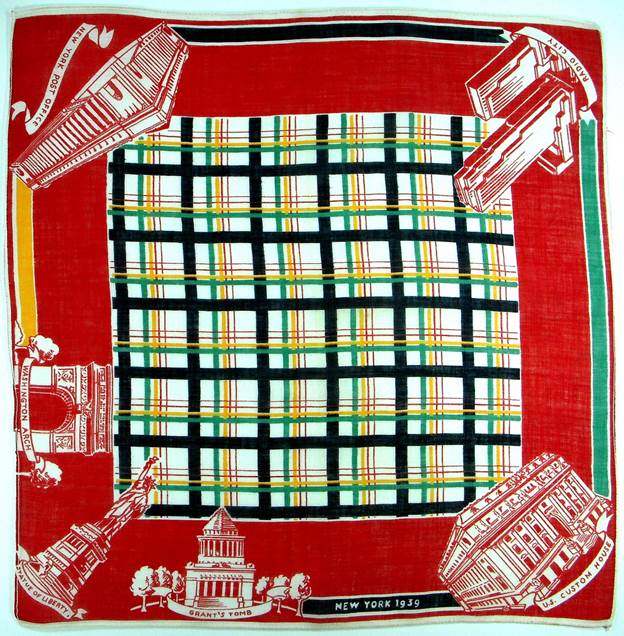
These hankies were reminders, that yes, you’ve visited an amazing Fair, with spectacles from around the world, but look what New York has to offer every day of the week. Breathtaking architecture, dynamic history, and one of a kind experiences, just waiting for you to explore and discover.
“As for New York City, it is a place apart. There is not its match in any other country in the world.”
Pearl S. Buck
It is impossible to capture the breadth, depth and magic that is New York or one of her Fairs in a blog. This is merely a glimpse into the past, a snapshot of history, and we hope you’ve enjoyed the journey.
Just for Fun
According to Wikipedia, the time capsule contained writings by Albert Einstein and Thomas Mann, copies of Life Magazine, a Mickey Mouse watch, a Gillette safety razor, a kewpie doll, a dollar in change, a pack of Camel cigarettes, millions of pages of text on microfilm, and more. The capsule also contained seeds of foods in common use at the time: wheat, corn, oats, tobacco, cotton, flax, rice, soy beans, alfalfa, sugar beets, carrots and barley, all sealed in glass tubes. The time capsule is located at40°44′34.089″N 73°50′43.842″W, at a depth of 50 feet (15 m). A small stone plaque marks the position.
For those who never visited the fair, he’s a personal reminiscence by Janet Lieberman. It’s casual and fun, and you feel as though you’re strolling with her.





I have a nice 1939 New York World’s Fair cotton handkerchief that I cannot find a match for online. Dimensions are 12″ x 12.5.” It is primarily white, with a red and blue border containing white words “1939 New York” repeated throughout. The center has the round seal of the State of New York, with date 1664 and the words: SIGILLUM CIVITATIS NOVI EBORACI. Surrounding the seal in a sunburst wheel pattern is a timeline of 48 key NY events from 1609 — Hudson River Explored, to, 1939 — The New York World Fair. The fabric is in very good condition (soft not crisp). Wondering if there is another one preserved somewhere such as in a New York museum. Are you familiar with this one? Just curious.
Goodness, there are so many wonderful designs, I can’t honestly say if I’ve seen this or not but it sounds simply wonderful.
CORRECTION: The center medallion is the seal of the City of New York.